Journal of Forensic Sciences & Criminal Investigation
Background: Determination of sex using odontometric analysis in Dimasa Kachari population of Assam. Method: This study was conducted in rural area of Dima Hasao district in three villages (Lumbding, Maibang & Haflong) of Assam, India. 61 Samples were collected from were 29 female and 32 male subjects between the age group of 18-57 years. Dental casts obtained by alginate impression after informed consent. These samples were observed for the sexual dimorphism and to find out their individual accuracy level using canine and first molar teeth measurements of maxilla and mandible. Univariate equations were formulated for tooth measurements which can be used to predict sex and population when any of the single teeth is found at crime scenes or mass disaster cases and to set a standard for this population which can be used as a standard in forensic investigation, mass disaster, personal identity, sex estimation in future for the population of Dimasa Kachari of Assam, India. Conclusion: In This study mesiobuccal distolingual distance (MBDL) for first molar of Maxilla shows 67.2% accuracy and distobuccal mesiolingual distance (DBML) for first molar of mandible shows 73.8% accuracy for sex determination using Univariate discriminant function analysis.
Keywords: Odontometric; Dental casts; Alginate impression; Dimorphism; Univariate; Mesiobuccal distolingual distance; Distobuccal mesiolingual distance
Abbrevations: CW: Canine Width; ICW: Inter Canine Width; IMW: Intermolar Width; BLD: Buccolingual Diameter; MDW: Meisodistal Width; MBDL: Mesiobuccal Distolingual Diameter; DBML: Distobuccal Mesiolingual Diameter; SD(±): Standard Deviation; D: Discriminant Score; SE(±): Standard Error; SP: Sectioning Point; SPSS: Statistical Package of Social Sciences
Main Text
Background: Sexual dimorphism using teeth has been extensively studied by means of odontometric analysis and most of the studies have shown statistically significant differences with t-test as well as with discriminant analysis based on data of permanent dentitions [1,2]. Odontometry has been performed on various tooth groups with the objective to establishing measurements that can act as standards and in this may also facilitate some procedures of dental surgeon as well as forensic odontology [3]. Tooth size standard based on odontometric analysis can be used as in age and sex determination [4]. In general, male teeth have been found to be larger than those of the female [5].
Assam has been the meeting place of different races and consequently a large number of ethnic groups have been residing in Assam. The Dimasa is one of the plain tribe of Assam inhabiting Barak Valley. They form a part of the greater Dimasa Kachari Society. Dimasa tribe, which belongs to Indo-Mongoloid Kachari group, is found in North East region of India. Tribal group Dimasa is one of the dominant tribal groups of the district of Dima Hasao. We have found no such studies on this tribe population regarding sexual dimorphism using dental measurements. The present study is an attempt to study the sexual dimorphism accuracy using canine and first molar teeth measurements of maxilla and mandible
According to studies, this has been reported that dental measurements have significant sexual dimorphism. Whereas it is also found that very few studies have set standards on population specific data which is of more importance. So, in the present study, an attempt has been given to set some dental data on the tribe population of Dimasa Kachari of Assam. This study would be helpful in finding out the relevant measurements which could differentiate sex with greater reliability as well as the individual accuracy level of all the measurements for sex determination by discriminant function analysis. These standards would be very useful help in identification of a person in any case of mass disaster, forensic analysis for personal identification, sex estimation etc.
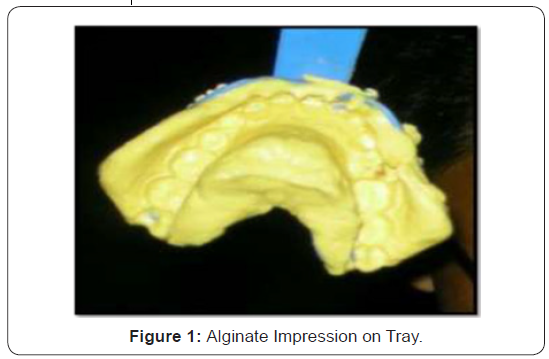
Methodology
Study sample was comprised of 61 dental casts obtained by alginate impression after informed consent, from 32 males and 29 females of the age group of 18-57 years, sharing same dietary habits (non-vegetarian). This study was conducted during March 2017. Samples were collected by door to door survey. Before sample collection, following general information was also recorded • Name of the subject • Age • Father’s sub-caste • Maternal uncle’s sub-caste Information regarding father’s sub-caste and maternal uncle’s sub caste helps us in evaluating the mating pattern among Dimasa Kachari population of Assam, India.
Exclusion criteria were applied
• Subjects having carious or missing mandibular and maxillary anterior teeth, • The presence of abrasion, attrition, spacing, and crowding, • Hard tissue diseases affecting the teeth were excluded from the study. • Sub-adults were excluded.
Making of study cast
Dental impressions on mandibular and maxillary arches were taken in alginate and study casts were prepared using Dental stone by pouring it in alginate impression of both the mandible and maxilla [3].
Method of Taking Measurements
The various parameters of teeth were measured using vernier caliper with a least count of 0.05mm
Measurements
I. Canine width (CW): It is taken as the greatest mesiodistal width between the contact points of the teeth on either side of the lower jaw. Measurements were taken with the caliper beaks placed [6,7]. II. Inter-canine width (ICW): It is measured as the linear distance between the tips of right and left canine [6,7]. III. Intermolar width (IMW): Distance between the lingual cusps of the corresponding molars in opposite quadrants. Measurements were taken on 1st molar [6,7]. IV. Buccolingual diameter (BLD):The distance between the outermost points of the molar crowns [6,7]. V. Meisodistal width (MDW): The greatest distance between the proximal surfaces of the molar tooth [6,7]. VI. Mesiobuccaldistolingual diameter (MBDL): The largest distance between the mesiobuccal corner and the distolingual corner of the crown [6,7]. VII. Distobuccal mesiolingual diameter (DBML): The largest distance between the distobuccal corner and the mesiolingual corner of the crown [2].
Results
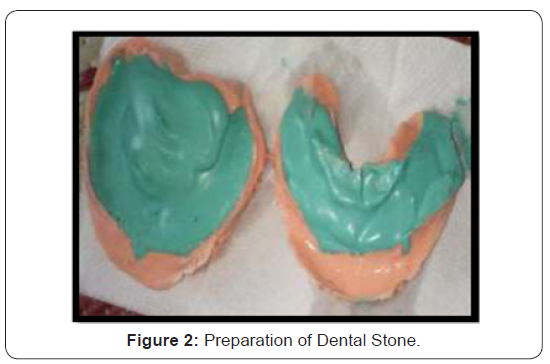
To accomplish the objectives of the present study, the data have been analyzed statistically. The chapter deals with the presentation and interpretation of the following aspects: • Assessment of sex differences in all the tooth measurements of Dimasa Kachari population of Assam, India. • Formulation of univariate discriminant function equations of all the tooth measurements • Assessment of original and cross-validated accuracies of all univariate discriminant functions.
Assessment of sex differences in all the tooth measurements of Dimasa Kachari population of Assam, India.
Data were subjected to descriptive statistics and t-test for assessing sex differences. Table 1 represents the mean, standard deviation, standard error of mean and dispersion for all the measurements of male and female tooth of maxilla. It is observed from the table that all the measurements have greater mean values for males except ICW and MDW which indicates that male teeth of maxilla are greater than female. Further it is noticed that the range values are higher in the ICW than other measurements in both male and female.
Table 2 represents the mean, standard deviation, standard error of mean and dispersion for all the measurements of male and female tooth of mandible. It is observed from the table that except than ICW, all the tooth measurements of mandible have greater mean values for males which indicate that male teeth are larger in size. Further it is noticed that the range values are higher in the ICW of female than other measurements which is also greater than the range value of male.
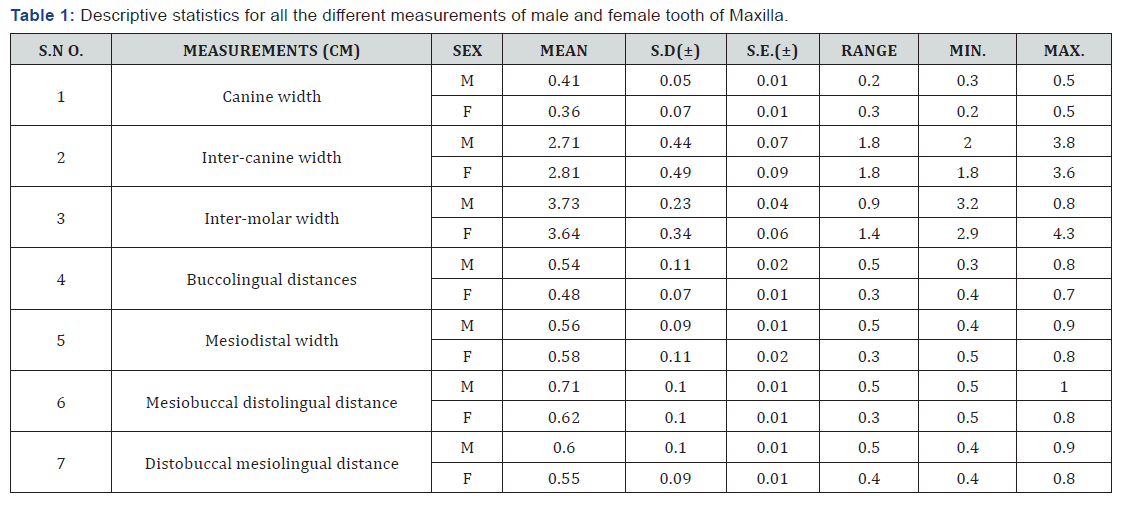
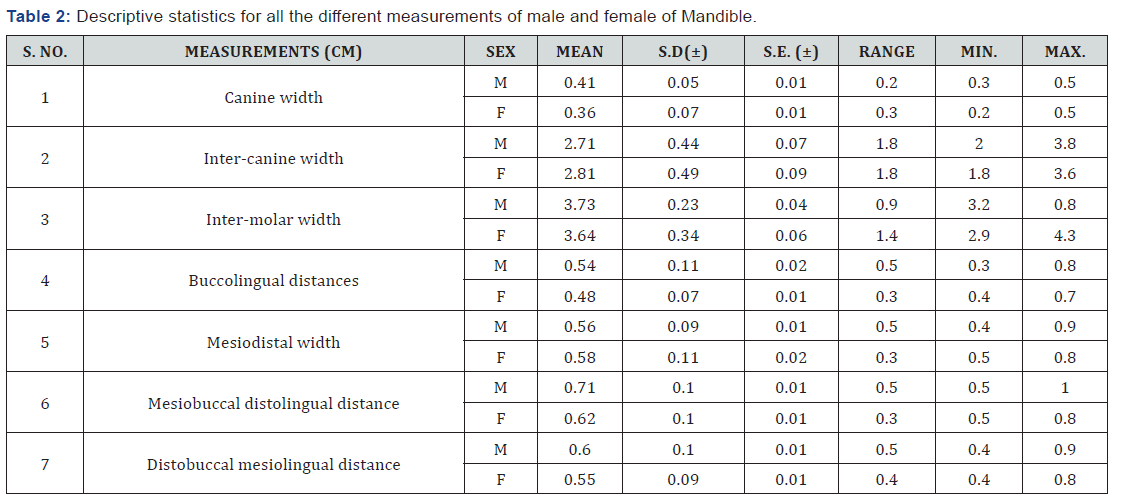
Table 3 Represents the results of t-test in order to access the sex differences in different tooth measurements of maxilla. It is observed from the table that all the measurements show significant sex difference (p> 0.05 level) except than ICW IMW and MDW. Table 4 presents the results of t-test in order to access the significant sex differences in different tooth measurements of maxilla. It is observed from the table that all the measurements show significant sex difference (p> 0.05 level) except than CW and IMW.
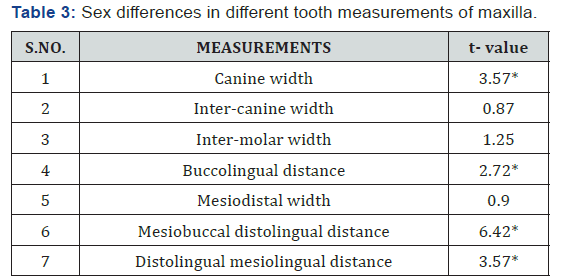
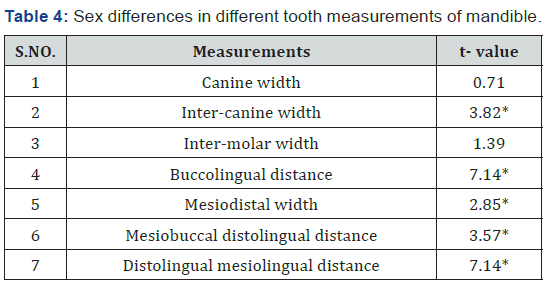

Table 5 Represents the raw coefficients, centroids, sectioning point, original accuracy percentages and cross-validated accuracy percentages of all the different measurements of male and female of maxilla. It is observed from the table that the highest significant contribution and accuracy is achieved from MBDL (original accuracy=67.2%; cross-validated accuracy=67.2%) and the least is achieved from MDW (original accuracy=52.5%; cross-validated accuracy=52.5%).

Table 4 presents the raw coefficients, centroids, sectioning point, original accuracy percentages and cross-validated accuracy percentages of all the different measurements of male and female of mandible. It is observed from the table that the highest significant contribution and accuracy is achieved from DBML (original accuracy=73.8%; cross-validated accuracy=73.8%) and the least is achieved from CW (original accuracy=53.5%; cross-validated accuracy=53.5%).
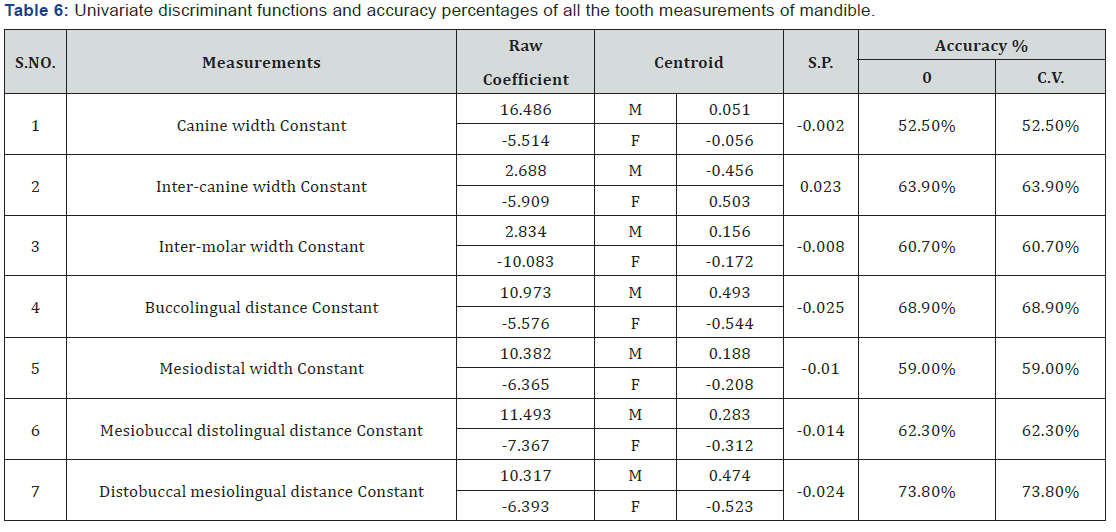
Assessment of original and cross-validated accuracies of all univariate discriminant functions

Original and cross-validated accuracies of all the univariate discriminant functions are calculated by discriminant function analysis and are presented in bar Graph 1. It is observed from the graph that in maxilla the highest original accuracy and cross-validated accuracy is achieved from MBDL (original accuracy=67.2%; cross-validated accuracy=67.2%) and the least is achieved from MDW (original accuracy=52.5%; cross-validated accuracy=52.5%) (Grapgh 2).
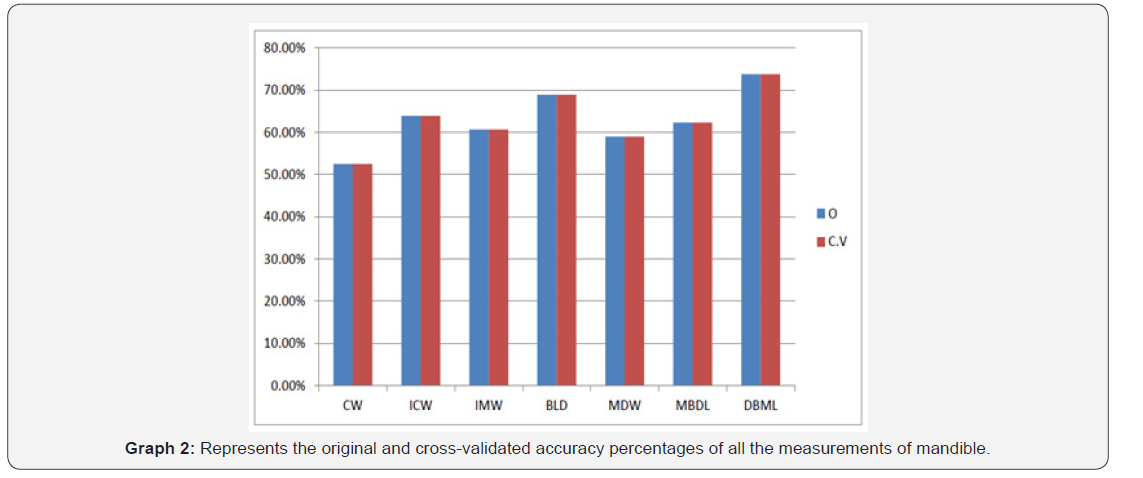
It is observed from the graph that in mandible the highest original accuracy and cross-validated accuracy is achieved from DBML (original accuracy=73.8%; cross-validated accuracy=73.8%) and the least is achieved from CW (original accuracy=53.5%; cross-validated accuracy=53.5%). Male values were exceeded female in all the observed dimensions except intercanine width, which shows reverse dimorphism.
The major work carried out by Garn et al. [2] identified the mandibular canine as displaying the greatest sexual dimorphism in human dentitions, and using a combination of teeth, reported an 86% success rate in correctly identifying sex. In our study mandibular canine does not show significant t-value but other molar measurements are giving the accuracy up to the level of 73.8%.
Further, in maxilla, mesiobuccal distolingual distance has got the highest accuracy that is 67.2% and in mandible distobuccal mesiolingual distance shows the highest accuracy that is 73.8%. Thus, these univariate equations are of very much practical importance and can be used for predicting sex with greater reliability.
Male values were exceeded female in all the observed dimensions except intercanine width, which shows reverse dimorphism. Reverse sexual dimorphism has also been observed in other populations Ticuna Indians Colombia, Nepalese, South Asian (Indians) [8].
Discussion
According to recent studies, molars are more reliable for sex estimation as it shows highly significant sexual dimorphism. While comparing the results of recent studies with the present study it was found that male’s teeth are larger than females which are in the agreement of present study. In present study we included canine and 1st molar measurements for finding significant sexual dimorphism [9,10].
In our study we have found that in maxilla, male’s shows higher mean values than females except inter canine width that is higher in females. The major work carried out by Garn et al. [2] identified the mandibular canine as displaying the greatest sexual dimorphism in human dentitions, and using a combination of teeth, reported an 86% success rate in correctly identifying sex. In our study mandibular canine does not show significant t-value but other molar measurements are giving the accuracy up to the level of 73.8%. Further, in maxilla, mesiobuccal distolingual distance for first molar has got the highest accuracy that is 67.2% and in mandible distobuccal mesiolingual distance for first molar shows the highest
accuracy that is 73.8%. Thus, these univariate equations are of very much practical importance and can be used for predicting sex with greater reliability.
Values for male’s were exceeded than female in all the observed dimensions except intercanine width, which shows reverse dimorphism. Reverse sexual dimorphism has also been observed in other populations Ticuna Indians Colombia, Nepalese, South Asian (Indians). (Acharya et al., 2007).
Conclusion
Data have been analyzed statistically by SPSS 16 for mean, standard deviation, standard error, dispersion, t-test, and univariate discriminant function analysis. By using all these statistical analysis in different measurements of tooth following observations were found in maxilla and mandible:
In Maxilla
• Highest percentage for correct sex classification was found for mesiobuccal distolingual distance by univariate discriminant function analysis that is 67.2%. • Least percentage for correct sex classification was found for mesiodistal width by univariate discriminant function analysis that is 52.5%.
In Mandible
• Highest percentage for correct sex classification was found for distobuccal mesiolingual distance by univariate discriminant function analysis that is 73.8%. • Least percentage for correct sex classification was found for canine width by univariate discriminant function analysis that is 52.5%.
Declaration
i. Ethics approval and consent to participate: The study was carried out after obtaining written consent from the subjects. The whole maneuver had been explained to the subjects and any unexpected risks that may appear during the course of the research had been declared to participants. ii. Availability of data and materials: “The dataset supporting the conclusions of this article is included within the article is included within the article and its additional file”. iii. Competing interests: The authors declare that they have no competing interests. iv. Funding: This study was funded by the authors. v. Author’s contributions: Kirti Sharma collected the samples, prepared impressions, analyse the data. Dr. Rajeev Kumar corresponding author revised this study. Dr. Deepali Jain analyzes the data, chooses the methodology and wrote the drafts of this study. All the authors read and approved the final manuscript
To
Know More About Journal of Forensic Sciences & Criminal Investigation Please click
on: https://juniperpublishers.com/jfsci/index.php
To Know More About Open Access Journals Please click on: ttps://juniperpublishers.com/index.php
To Know More About Open Access Journals Please click on: ttps://juniperpublishers.com/index.php





No comments:
Post a Comment